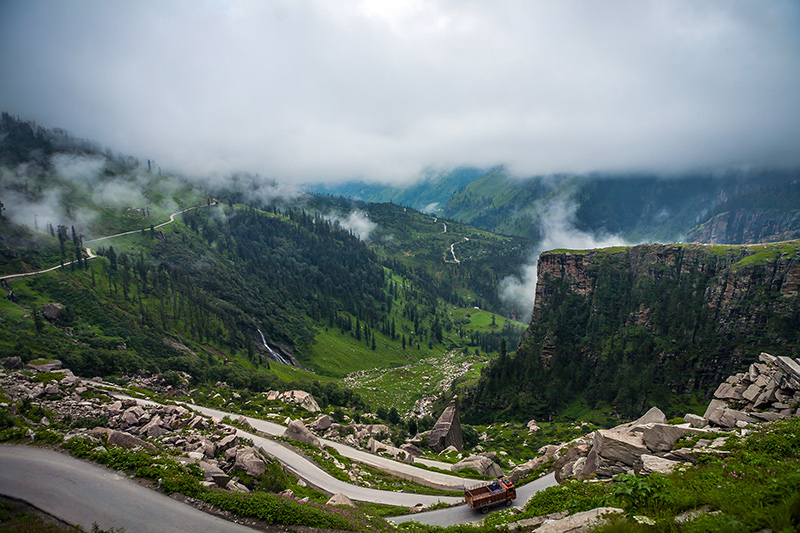Spiti Valley, a sensationally magnificent place is situated at an altitude of 3800m above sea level between the spectacular mountain terrains in the north-eastern region of Himachal Pradesh. The word “Spiti” means ‘the middle land’ and this name was given as it lies between Tibet and India. As the area lies in the cold desert region, during the winter season the temperature of this place is as low as -20°C, while in summer the temperature lies in the range of 16-20°C. As it is near to Tibet, the cultural influence of the region can be seen here in the form of Buddhism. The ancient Buddhist monasteries, trekking trails, beautiful rivers and the breath-taking view of the landscapes are the main reasons to visit and explore this place. Buddhism is the locus of this place, so the main attraction of the region is the Buddhist monasteries which consist of vibrant thangkas, colourful paintings, artifacts and ancient sculptures. The language spoken by locals is Stod Bhoti which is a subgroup of the language spoken in the Tibet region.

The historical background of this place tells us that once the place used to have a reserved culture where the focus lay in and around the Buddhist culture and its monasteries. It was then ruled by self-styled waziers called “NONO” while in between the place became a victim of the attacks by invaders from neighbouring regions. After invaded by different rulers, finally this place came under the rule of the East India Company in 1846 after the First Anglo-Sikh War. But on the ground, this place was still ruled by the hereditary ruler of Spiti “Nono”. Inspite of the harsh climate and dangerous terrain, this place is the best for viewing the rich Buddhist culture, Himalayan lakes and the charm of the solitude and spirituality hidden in the beauty of the Himalayas. The remote places and wildlife sanctuary give an overall completeness to this place. Kibber, the highest inhabited village of this place is home to the dangerous snow leopard which has given a different aspect to this place in terms of wildlife hotspot, offering wildlife lovers a glimpse of the dangerous big cat in the terrain. The places to explore in Spiti valley are as follows –
Lhalung Monastery

This monastery got its name after the place “LHALUNG” which is situated at an altitude of 3,660m having rich diverse flora particularly Sea Buckthorn trees. It was founded by Rinchen Zangpo who was the King of Guge in the late 10th century. This place is described as the “Land of Gods” and the Lhalung deity is considered to be the head of all deities in the valley. The monastery consists of different coloured statues where each colour has its own significance, that is, red signifies anger, blue signifies hurt and yellow signifies happiness.
Tabo Monastery

It is situated at an altitude of 3050m and was founded in 996 AD, it is the oldest monastery having its own significance. It is believed that the Dalai Lama will retire from his duties at this iconic place. The monastery consists of a public library, assembly hall, marvellous art work, meditation caves and enthralling statues. Beside this, there are nine temples in the complex of the monastery.
Rohtang Pass

The two main places in Himachal Pradesh i.e. Spiti and Lahaul district is surrounded by mountain ranges. Rohtang Pass mainly separates the Lahaul and Spiti region from the Kullu Valley and is situated at an altitude of 3,979m. Due to heavy snowfall, landslides and thick icing conditions, the road connectivity is cut-off from the region for almost eight months in the winter and spring seasons. While the southern road connectivity to the rest of the country is periodically closed for a brief duration in the month of November due to winter storms the road access is restored a few days after the storm ends via the Shimla route.
Kaza

According to the level of altitude, the valley of Spiti is subdivided into three portions namely… lower, middle and upper. Kaza comes under the upper region and is the main administrative centre of the region. It is situated at an altitude of 3,800 m and is a popular base for the nature lovers. This place offers a spectacular view showing the stark beauty of the region surrounded by heavenly mountains and rivers. Kaza is the sub-divisional headquarters of Himachal Pradesh and is located near the spiti river.
Langza Village

Langza is a small village nestled in a bowl-shape between the mountains situated at an altitude of 4,420m. It is home to the colourful vibrant statue of Lord Buddha presiding over it. It is one of the remotest villages of the region residing in a remote corner of the state. Also known as the ‘Fossils Hub’ as fossils of plants and marine creatures are found here in plenty under the sedimentary rocks which are believed to be over millions of years old.
Komic Village

Komic village is home to Spiti Valley’s highest monastery and being the highest village in Asia with an altitude of 4,587m. This place is famous for offering few laid-back guest houses. Komic monastery is a small monastery situated in this region which is situated on a daunted hilltop.
Kunzum Pass

Spiti Valley is believed to be the gateway to the northernmost part of the country. This gateway is connected through various passes, among which is the Kunzum Pass. The northern route from Keylong via Kunzum Pass lies in the eastern part of the state and form a part of Spiti and Lahaul district. So, in short, Spiti and Lahaul valley are cut-off from each other by the Kunzum Pass which is situated at an altitude of 4,590m.





